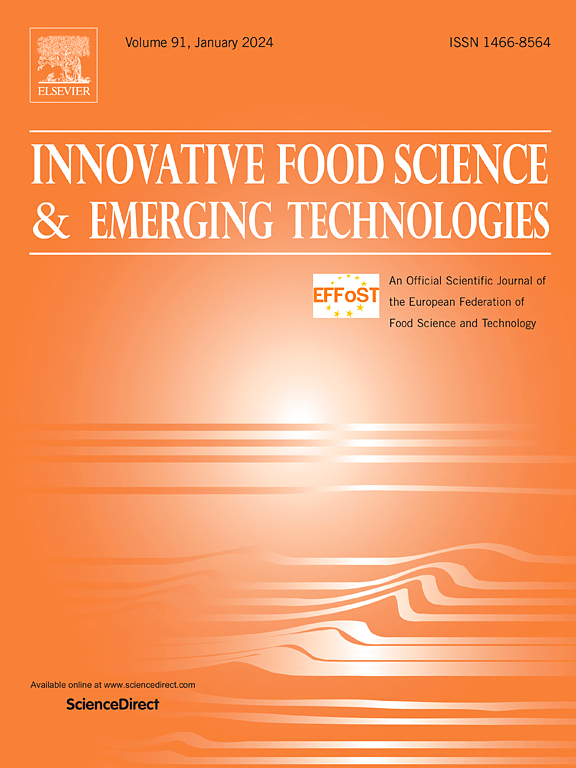Moisture migration model of packed fresh-filled pasta during storage under different humidity conditions
IF 6.3
1区 农林科学
Q1 FOOD SCIENCE & TECHNOLOGY
Innovative Food Science & Emerging Technologies
Pub Date : 2025-01-12
DOI:10.1016/j.ifset.2025.103930
引用次数: 0
Abstract
Water migration in multi-component foods is one of the most significant factors limiting their shelf life. Therefore, a two-component model (pasta and filling) was proposed simulating storage in permeable packaging under two different humidity conditions (70 % and 100 % relative humidity (RH)) to model the moisture changes over time in fresh-filled pasta. Several sensors monitored moisture changes inside the packaging and the environment during storage. The moisture sorption isotherms (MSI) were determined on pasta and filling at 6 °C and 11 %–98 % relative humidity (RH) and fitted using the GAB equation. Depending on the RH condition, the water content of pasta and its filling changed during storage. Pasta in direct contact with the filling adsorbed water, and this did not depend on water permeating through the package but on the water that the filling released. Thus, the higher water affinity of pasta and the high free water content in the filling determine the initial water movement from the filling to pasta independent of their activity water values. The MSI, water transmission rate of the packaging, and multi-component food characteristics predicted the moisture gain or loss by the pasta-filling system during storage. A correction factor was introduced in the model because the data obtained from the humidity sensors suggested the formation of a humidity gradient inside the package and environment. The experimental data closely matched the model predictions.
不同湿度条件下包装鲜馅面食贮藏过程中的水分迁移模型
多组分食品中的水分迁移是限制其保质期的最重要因素之一。因此,提出了一个双组分模型(面食和馅料)来模拟两种不同湿度条件下(70%和100%相对湿度(RH))在可渗透包装中的储存,以模拟新鲜面食中水分随时间的变化。几个传感器监测包装内部的湿度变化和储存过程中的环境。在6°C和11% - 98%相对湿度(RH)条件下,测定了面食和馅料的吸湿等温线(MSI),并用GAB方程拟合。在不同的相对湿度条件下,面食及其馅料的含水量会发生变化。与馅料直接接触的面食会吸附水分,而这并不取决于水通过包装的渗透性,而是取决于馅料释放的水分。因此,面食较高的亲水性和馅料中较高的自由水分含量决定了从馅料到面食的初始水分运动与它们的活性水分值无关。MSI、包装的水分传递率和多组分食品特性预测了意大利面灌装系统在储存过程中的水分获得或损失。由于从湿度传感器获得的数据表明在包装内部和环境中形成了湿度梯度,因此在模型中引入了校正因子。实验数据与模型预测非常吻合。
本文章由计算机程序翻译,如有差异,请以英文原文为准。
求助全文
约1分钟内获得全文
求助全文
来源期刊
CiteScore
12.00
自引率
6.10%
发文量
259
审稿时长
25 days
期刊介绍:
Innovative Food Science and Emerging Technologies (IFSET) aims to provide the highest quality original contributions and few, mainly upon invitation, reviews on and highly innovative developments in food science and emerging food process technologies. The significance of the results either for the science community or for industrial R&D groups must be specified. Papers submitted must be of highest scientific quality and only those advancing current scientific knowledge and understanding or with technical relevance will be considered.

 求助内容:
求助内容: 应助结果提醒方式:
应助结果提醒方式:


